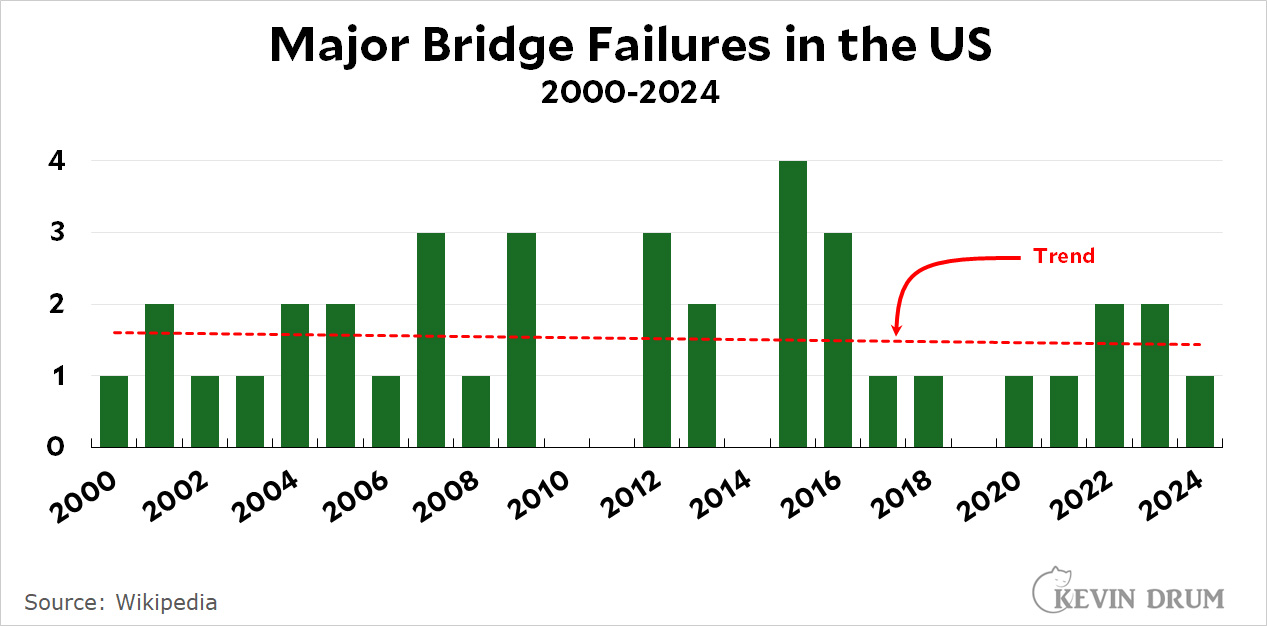Just in case you're curious, here's the annual rate of bridge failures in the US:
 There's no trend either up or down. It's perhaps also worth noting that virtually none of these failures were due to age or bad design. The vast majority failed due to floods, being hit by trucks, being hit by barges, or by construction work.
There's no trend either up or down. It's perhaps also worth noting that virtually none of these failures were due to age or bad design. The vast majority failed due to floods, being hit by trucks, being hit by barges, or by construction work.

This was not a bridge "collapse". This was a bridge knocked down.
A bridge collapse is due to some error in the bridge construction. This was an error in a corporate ship, and the company that owns the ship (and its insurance company) are responsible for the bridge being knocked down and should be held 100% responsible for paying for it.
This table makes no sense, and that wikipedia list is all over the place
the 2001 Atlanta incident was not a failure or collapse. they fixed it and reopened it in 4 weeks
two of the 2012 events were pedestrian bridges, one wood
by 2015 the bob white bridge had not been used by vehicles for 20+ years
these should not be lumped together with I35 collapse...
As someone who does not know the field at all I will note a few things. The channel where the boat passed under the bridge is very narrow. Big tanker ships will simply knock out similarly built bridges if they collide with the base. Here is my surprise, ships lose power at a higher rate than I thought. You see where this is going? What happened was eventually was going to happen. Similarly calculations exists with subways and airplanes and how we calculate losses under the current capitalist system needs to change. Nobody demands perfection but we can mitigate risks- should the ship be going at 9 km per hour in a tight channel? Should tug boats have untethered so soon? Can bridge base be built with a better capacity to withstand shock? Can ships keep a semblance of control under power loses? Unless we adapt, situations like this will happen again, it is just statistics.
As to speed, control of a vessel requires flow over the rudder. That's elementary. In a seaway with varying conditions (tidal run, river current, wind, especially wind with that giant surface area, what a monster Dali is), speed is crucial for control. Every vessel is different, but I'm betting that Dali needed that speed for any sort of control. The power problem is electrical in nature. I don't know if there was an auxiliary generator but there should be one...
I did look up her specs, a single engine for a single screw. That's for economy during the voyage. It's not ideal at all for maneuver, but again that's not her job. I'm fairly certain that the black plume was the engine going full reverse in a emergency order (every vessel I served in did the same thing when a big speed change or start up happens). But she was 100,000 tons. At full reverse, I don't know how many ship lengths to stop but I bet it was probably a mile or two.
As for channels, the Chesapeake is shallow naturally. The channels are dredged and maintained constantly. To make a larger channel would be prohibitive. It's the companies chasing profit with ever larger ships that are pushing the limits. A panamax or neo-panamax vessel is at the very limit of these places. Take a look and you'll find ports doing massive work to accommodate these monsters.
It all boils down to profit.
We don't know what made The Devi lose power, but there has been trouble with fuel for the current generation of diesel powered ships. Seems the back in the old days steam turbines could burn about anything, and fuel companies got in the habit of dumping whatever they had left over from the refining process in to ship fuel, rather than paying to have it incinerated in a waste disposal facility. The giant diesels that power today's ships are pickier about their fuel and have been having more fuel related engine failures. Some claim that modern low sulfur fuel actually makes the diesels more sensitive to burning crap in their fuel. One definite issue has been the requirement switch to low sulfur fuel when entering U.S. waters. Ships have experienced engine problems when they switch fuels coming into or leaving U.S. waters.
[Gamma-ray burst hits planet Earth, sterilizing the land masses on half the planet]
Kevin Drum: "Meh. Charting mass extinctions over the past 4 billion years, we see that the frequency and magnitude of such events is flat or even declining. If anything, biodiversity growth since the Carboniferous and a shrinking number of potential impactors in the solar system means life on Earth is as safe as it has ever been."